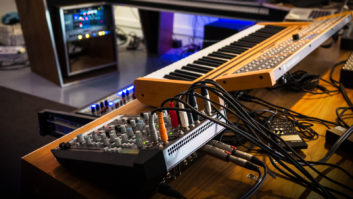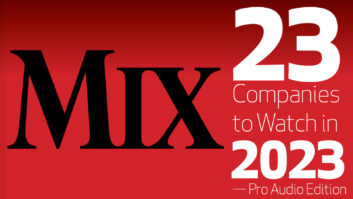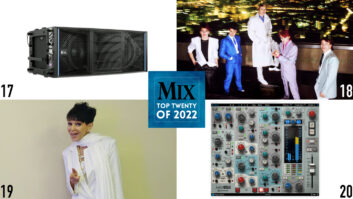
RØDE NTG3 SHOTGUN MIC
RØDE NTG3 SHOTGUN MIC
April 2008—For broadcasting and location recording, RØDE (www.rodemic.com) unveils the NTG-3 (street price $599), its third-generation shotgun mic design. The 10-inch-long, ¾-inch-diameter body is ideal for on-camera, boom or handheld use; it features low handling noise and ultralow self-noise. (EIN is 13 dBA per IEC 651.) The externally RF-biased, true condenser capsule has a high level of RFI rejection and requires standard 48VDC phantom power. The Aussie-made mic includes a mic clip, windscreen, carry pouch and a nearly indestructible aluminum storage/transport cylinder for maximum protection. Options include mini- and full-sized extendable boom poles, shock-mounts and a fur-style windshield.
LAWO ZIRKON 2.8
Lawo’s (www.lawo.de) Zircon on-air radio console now features significant enhancements to its system control and configuration software, as well as its VisTool touchscreen-surface visualization software. A new Sig80 DSP mode supports an additional 40 DSP channels (mono/stereo) with EQ, dynamics and limiting via a second master board. Performance and communication have been improved by using UDP (User Datagram Protocol) rather than TCP. Because UDP avoids the system overhead of checking every last data packet, metering response is faster and provides greater compatibility in networked environments. The VisTools software upgrade lets users display 24 channels simultaneously, with the ability to set EQ parameter and marker colors.
CELEMONY MELODYNE VERSION 2
Fresh from Musikmesse in Frankfurt, Celemony (www.celemony.com) has released a breakthrough version of the Melodyne plug-in. Version 2 features Direct Note Access (DNA), which, for the first time, will “explode” polyphonic material in the Melodyne Editor’s window so that the user can see all of the notes of a chord displayed at their actual pitches and edit them individually using the familiar Melodyne tools. Users have access to the pitch, position in time and duration of each note, as well as its vibrato, pitch drift, formant spectrum and volume. Practical uses range from pitch-tuning individual notes of a chord, eliminating bad notes or re-voicing a chord and creating new parts long after the player has left the building. The plug-in supports VST, Audio Units and RTAS-compatible host apps, and customers purchasing Melodyne will receive the update free of charge.
AKAI MPD32 CONTROLLER?
Offering control of popular music-making apps — such as Propellerhead Reason, Ableton Live, Apple GarageBand and more — the fully programmable MPD32 ($499) controller from Akai Professional (www.akaipro.com) claims to be the only pad controller that can also work as a master clock for MIDI sequencers while offering MPC Note Repeat with swing and gate-time parameters. The MPD32 connects to a PC or Mac via USB, and has 16 velocity/pressure-sensitive MPC pads, eight assignable faders, eight assignable switches and eight assignable 360-degree knobs. Three selectable control banks extend the number of available faders, buttons and knobs to 24 each (72 total controllers) while four pad banks provide 64 total pads. The MPD32’s transport controls can interface with DAW/sequencing applications like Cakewalk SONAR, Steinberg Cubase and Apple Logic.
BLUE MICROPHONES JOE CONDENSER
Promising not to be your average Joe, this mic from Blue (www.bluemic.com) is a cardioid, large-diaphragm condenser model that features a copper-toned, anodized-finish, Class-A discrete electronics and hand-tuned/tested capsules built on the pedigree of Blue’s Dragonfly, Kiwi and Bottle microphone system. Joe ($499) ships with an integrated swivel mount and velvet storage bag.
DYNAUDIO ACOUSTICS AIR 12 SERIES MONITORS
The AIR 12 Series studio monitors from Dynaudio Acoustics (www.dynaudioacoustics.com) includes the $2,495 AIR 12 Master AD (with stereo analog and AES/EBU digital inputs), the AIR 12 Master D6 (with six channels of AES/EBU inputs) and the $2,095 AIR 12 Slave active monitor (with TC Link input). Each monitor features a 1.1-inch, soft-dome tweeter and 8-inch woofer for a 37-22k Hz response. AIR 12 includes AIR monitor control with central remote control, preset storage and recall, calibrated levels and integrated bass management. Other features include internal precision EQs and delay lines, and the ability to configure the system in stereo, 5.1 monitoring and larger setups using AIR 12 or other AIR Series networked monitors.
RYCOTE INVISION
Rycote’s (www.rycote.com) latest noise-reducing suspensions for compact mics, the InVision Series features a patented design called the Lyre, comprising virtually unbreakable dual W-shaped clips of varying sizes. The INV-1, INV-2 and INV-3 are designed for use with desk, stand-mounted or hanging mics. The remaining five sizes in the range, INV-4 to INV-8, are intended for use with boom-mounted mics. The different models use Lyres of varying sizes to fit different length/diameter mics from various manufacturers. INV-1, for example, fits the AKG C 747, Audio-Technica ATM350, Sennheiser ME36 and Schoeps CCM. INV-2 fits the RØDE NT6 and Sennheiser MKH8000 Series (remote).
SYNTHOGY IVORY UPRIGHT PIANOS
Synthogy (dist. by Ilio, www.ilio.com) has released Ivory Upright Pianos ($299), featuring different pianos sampled in up to 10 velocity layers with a separate, selectable “creaks and clunks” layer for added realism. Pianos include Vintage Upright, Honky Tonk Barroom Upright and Tack, among others. This virtual instrument comprises more than 50 GB and more than 5,000 samples that works stand-alone or as a plug-in with Audio Units, VST (Mac/PC) and RTAS (Mac/PC) hosts. It requires an iLok.
MXL V88 CONDENSER MIC
The V88 ($349), a general-purpose mic from MXL (www.mxlmics.com), is a large-diaphragm (32mm), pressure-gradient condenser with a fully balanced transformerless output. Internally wired with Mogami cable, the V88 offers low self-noise, 138dB SPL rating, Class-A electronics, nickel-plated finish and a low-profile form factor — less than six inches in overall height. It ships with an aluminum flight case and shock-mount adapter.
YAMAHA POCKETRAK 2G
A light, compact pocket recorder featuring 2 GB of built-in memory, the $449 Pocketrak 2G from Yamaha (www.yamaha.com) offers USB file transfer, Steinberg Cubase AI DAW software and two tracks of CD-quality recording in PCM, MP3 and Windows Media formats. It includes a rechargeable AAA nickel-hydrogen battery, providing 19 hours of MP3 recording. Plugging its sliding USB connector into a powered USB bus simultaneously recharges the battery and transfers files to a PC or Mac. It also has an onboard speaker, headphone jack, USB extension cable, stereo earphones, leather carry case and stand adapter.
SONTRONICS CHIMERA
This single-channel preamp/DI box from Sontronics (www.sontronics.com) offers two discrete circuits: one solid-state and one tube. Features include 60 dB of gain, a switchable highpass filter (100 or 200 Hz), switchable phantom power, -10/20dB pad, phase invert, master output attenuator, signal-present LED and VU meter. This handsome black desktop unit also has front panel XLR and ¼-inch instrument inputs. Price: $1,399.
AUDIOKINETIC WWISE MOTION
Bringing the gift of rumble to audio and motion-designing middleware jockeys, Audiokinetic’s (www.audiokinetic.com) Wwise Motion Tool V. 2008.2 allows the game production team to adjust such properties as volume, pitch or LPF to fine-tune the motion effect. Any motion generated using Wwise Motion can be automatically created and customized for all platforms, including Windows, Sony PlayStation 3, Microsoft Xbox 360 and Nintendo Wii. In addition, the plug-in SDK allows you to support any peripheral that is not yet supported by Wwise Motion. A plug-in for the D-BOX chair is now available for PC. The app is extremely light, causing virtually no impact on CPU or memory usage.
NEURAL-THX SURROUND
Expanding the barriers of broadcast and game audio to 7.1, Neural-THX surround technology (www.neuralsurround.com) lets broadcasters and game developers encode 5.1 content during a live mix or post session, transmit the content in a stereo format over existing channels and decode the original 5.1 mix through a Neural-THX Surround-enabled playback device. For the listener, this offers a consistent surround sound experience, regardless of the compression type. Expanding the game audio experience to 7.1 allows gamers to add two additional rear speakers, creating a 360-degree listening environment. When playing in Neural-THX Surround, sound elements will be placed in front, to the side and behind gamers.
MARANTZ PMD580 RECORDER
The newest addition to its family of rackmount digital recorders, the $1,399 PMD580 from Marantz (www.d-mpro.com) brings network connectivity to the line. Via its Ethernet port, the PMD580 can be positioned as a network device, allowing users to set menu parameters, schedule recording events, and transfer and archive audio files — all by using a Web-based GUI interface from any PC or Mac in the network. I/O includes balanced XLR inputs and outputs, S/PDIF and AES/EBU digital interfaces, and RS-232 control. The unit offers MP3 and WAV recording formats, and users can select between 16- and 24-bit resolution.
NADY SYSTEMS RSM-8A
The RSM-8A active ribbon mic from Nady (www.nady.com) has a low-tension, 50mm-long, 2-micron-thick aluminum-ribbon (velocity) design. Gain is said to be 40 dB higher than most non-active ribbon mics. Features include 165dB SPL capability, -10dB pad and low-cut filter switches for attenuation and elimination of stage rumble. The figure-8-patterned mic features an integral stand mount.
SHANE WILSON’S GUIDE TO MIXING
Featuring more than four hours of video with top Nashville engineer Shane Wilson, this $79.95 DVD from Audioinstruction (www.audioinstruction.com) chronicles a mix session from start to finish, preserving every nuance of Wilson’s technique. It offers tips on working quickly, along with plug-in settings and documentation of every piece of gear used within the session. Included are the original, separate audio files from the session so users can import the 24-bit WAV files into their own DAW to try their own mix. The DVD also has a discussion and comparison of mixes printed to several different mix paths, including various A/D converters, ½-inch tape, a Neve summing mixer and more.







